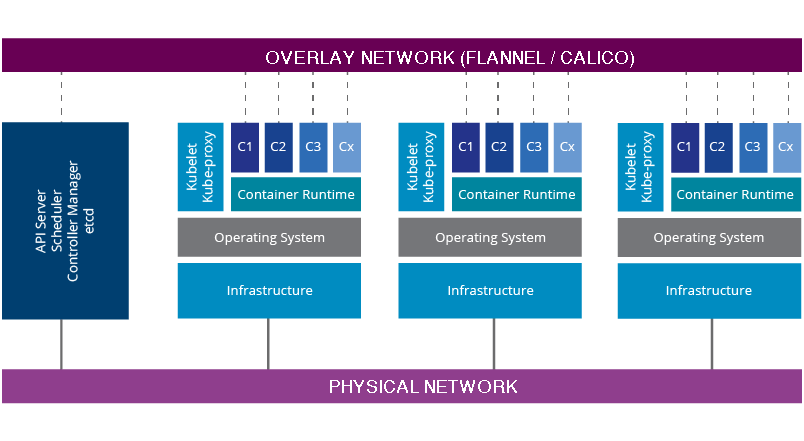Why kubernetes can make our life easier?
Fernando Ripoll
Docker?
The premise of docker
BUILD ONCE
RUN ANYWHERE
VMS vs containers?

How works?

Kubernetes?
Kubernetes
It is an open source system to manage containerised applications across multiple hosts, providing basic mechanisms for deployment, maintenance and
scaling of applications
Strengths of kubernetes
- Velocity
- Stateless
- Declarative configuration
- Self-healing platform
- Immutability
- Programable
Architecture
K8s is composed by a master and minions (nodes). A master contains the key components and nodes connect to it via an secure API thanks to an agent.

Master
- API server
It is the frontend control panel to manage kubernetes resources/objects - Control Manager
It is in charge of maintain the desired state - Scheduler
Select in which node a new container has to run
- Etcd
Is a distributed data storage used by kubernetes to store configuration and state
Nodes
- Docker (or rkt)
Underlying application container runtime - Kubelet
Is the agent which talks with apiserver and performs actions requested and monitor the node containers - Kube-proxy
Collaborates to maintain the VXLAN network
Networking
It uses a container networking provider to create a VXLAN
- All containers can communicate with the rest without NAT
- All nodes can communicate with all containers (and vice-versa) without NAT
- Every container (pod) has a unique IP within the cluster
- Developer has not to set up network configuration
Kubectl (CLI)
It is a command line interface for running commands against the cluster(s)
kubectl [command] [TYPE] [NAME] [flags]
DEMO
Objects and labels
They are persistent entities used to represent the state of your cluster (defined as yaml or json docs).
Labels are key/value attached to objects for organazing and select group of objects
apiVersion: #version of the Kubernetes API
kind: #object type to create
metadata: #name, labels, namespace
spec: #Specification like container image, restart policy,...
Pod
The most basic resource
- Wraps an application container(s)
- A unique IP (network)
- Encapsulate storage
- Represents a single unit of deployment
- Can limit resources

Pod
Lets create a pod object definition
DEMO
apiVersion: v1
kind: Pod
metadata:
name: single-pod
spec:
containers:
- name: my-awesome-app
image: 172.17.4.1:5000/my-awesome-app:0.0.0
Pod
Lets create a pod object definition with multiple containers
DEMO
app
echo
shared-data
Multi container pod example
curl
Replica set
Is a controller that helps to control pods
- Before known as Replica Controller
- Maintain a number of replicas
- Used by deployment
- Managed by HPA (horizontal pod autoscaler) to scale
number of replicas
Replica set
DEMO
apiVersion: v1
kind: ReplicaSet
metadata:
name: my-awesome-app
spec:
replicas: 3
template:
containers:
- name: my-awesome-app
image: 172.17.4.1:5000/my-awesome-app:0.0.2
Deployment
Is a controller one level up
- Control ReplicaSet resources
- Do rollout of new or update of our containers
- Do rollback of current deployments
- Scale up/down containers
Deployment
The specification is the same as previous example
apiVersion: v1
kind: Deployment
metadata:
name: my-awesome-frontend-app
spec:
replicas: 2
template:
containers:
- name: my-awesome-app
image: 172.17.4.1:5000/my-awesome-frontend-app:0.0.1
DEMO
Service
Group a set of pods under an IP
- Lets pods communicate between them
- Decouple the service implementation
- Match pods by labels
- Create the endpoints to route requests
- Can resolve domains thanks to a DNS addon
- There are three types of service
- ClusterIP
- NodePort
- LoadBalancer
Service
apiVersion: v1
kind: Service
metadata:
name: mongo
spec:
selector:
db: mongo
ports:
- port: 27017
protocol: TCP
DEMO
More objects
Other useful resources available
- Secret
- Daemon set
- Job / Cron Job
- Statefulset
- Ingress
- Config map
- ...
Projects around
Interested projects running upon k8s
- Service mesh (Istio/Envoy)
- Open tracing (Jaeger)
- Monitoring (prometheus)
- Logging (ELK)
- Open FAAS (serverless)
- ...
https://landscape.cncf.io
Thanks
Code available on
https://github.com/pipo02mix/why_k8s_can_make_our_life_easier
@pipo02mix
info@tiatere.es